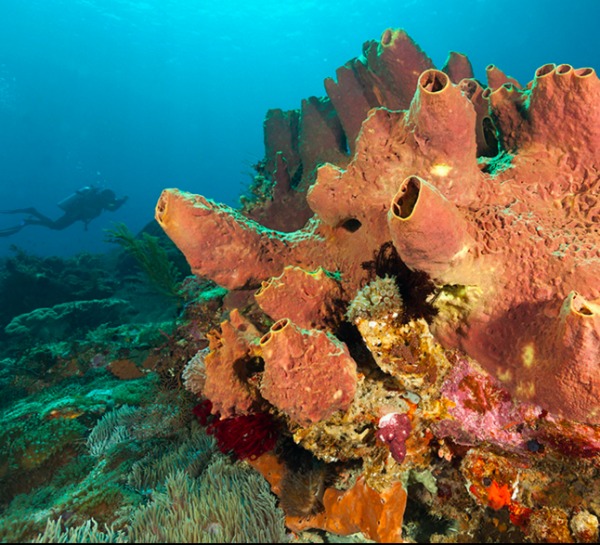A new study by a team of MIT scientists suggests that sea sponges might have been the first animals to inhabit the Earth. The researchers’ genetic analyses confirm that sea sponges are the source of a curious molecule found in rocks that are 640 million years old. These rocks significantly predate the Cambrian explosion — the period 540 million years ago in which most animal groups took over the planet. The research was published February 22, 2016 in the Proceedings of the National Academy of Sciences.
Paleontologists have unearthed an extraordinary number of fossils from the period starting around 540 million years ago. Based on the fossil record, some scientists have argued that contemporary animal groups essentially “exploded” onto Earth, very quickly morphing from single-celled organisms to complex multicellular animals in a relatively short geological time span. However, the fossils that are known from before the Cambrian explosion are peculiar in many respects, making it extremely difficult to determine which type of animal was the first to the evolutionary line.
The MIT researchers looked for the answer in molecular fossils — trace amounts of molecules that have survived in ancient rocks long after the rest of an animal has decayed away. David Gold is a postdoc in MIT’s Department of Earth, Atmospheric and Planetary Sciences and the paper’s lead author. Gold said:
There’s a feeling that animals should be much older than the Cambrian, because a lot of animals are showing up at the same time, but fossil evidence for animals before that has been contentious. So people are interested in the idea that some of these biomarkers and chemicals, molecules left behind, might help resolve these debates.
EarthSky’s once-a-year fundraiser going on now. Please donate to help us keep going!

In particular, he and his colleagues have focused on 24-isopropylcholestane, or 24-ipc for short — a lipid molecule that is a modified version of cholesterol. In 2009, researchers confirmed the presence of 24-ipc in 640-million-year-old rock samples from Oman, potentially representing the oldest evidence for animal life.
It’s known that some modern sea sponges and certain types of algae produce 24-ipc today, but which organism was around to make the molecule 640 million years ago? To answer this question, the MIT team sought to first identify the gene responsible for making 24-ipc, then find the organisms that carry this gene, and finally trace when the gene evolved in those organisms.
The team looked through the genomes of about 30 different organisms, including plants, fungi, algae, and sea sponges, to see what kinds of sterols each organism produces and to identify the genes associated with those sterols.
By comparing genomes, they identified a single gene, sterol methyltransferase, or SMT, responsible for producing certain kinds of sterols depending on the number of copies of the gene an organism carries. The researchers found that sea sponge and algae species that produce 24-ipc have an extra copy of SMT when compared with their close relatives.
The researchers compared the copies to determine how they were all related and when each copy of the gene first appeared. They then mapped the relationships onto an evolutionary tree and used evidence from the fossil record to determine when each SMT gene duplication occurred.
No matter how they manipulated the timing of the evolutionary tree, the researchers found that sea sponges evolved the extra copy of SMT much earlier than algae, and they did so around 640 million years ago — the same time period in which 24-ipc was found in rocks.
Their results provide strong evidence that sea sponges appeared on Earth 640 million years ago, much earlier than any other life form.
Enjoying EarthSky? Sign up for our free daily newsletter today!
Bottom line: A study published February 22, 2016 in the Proceedings of the National Academy of Sciences by a team of MIT scientists suggests that sea sponges might have been the first animals to inhabit the Earth.











